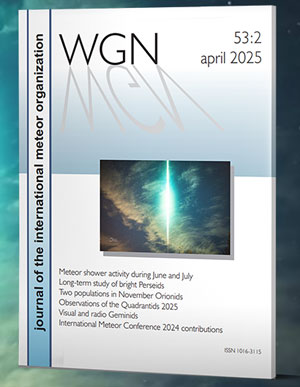Meteor activity in general increases in October
when compared to September. A major shower (the Orionids) is active most of the
month along with several minor showers. Both branches of the Taurids become more
active as the month progresses, providing slow, graceful meteors to the nighttime
scene. The Orionids are the big story of the month reaching maximum activity on
the 22nd. This display can be seen equally well from both hemispheres which
definitely helps out observers located in the sporadic-poor southern
hemisphere this time of year.
During this period the moon reaches its full phase
on Sunday October 4th. At this time the moon lies in the sky all night long and
severely hampers meteor observations. A small window of dark skies opens later in
the week as the waning gibbous moon rises later in the evening allowing a couple
of hours of dark sky between the end of evening twilight and moonrise. The
estimated total hourly rates for evening observers
this week is near three as seen from the northern hemisphere and two from the
southern hemisphere. For morning observers the estimated total hourly rates should
be near seven from the northern hemisphere and four as seen from the southern
hemisphere. The actual rates will also depend on factors such as personal light
and motion perception, local weather conditions, alertness and experience in
watching meteor activity. All rates are severely reduced by bright moonlight.
The radiant positions and rates listed below are exact
for Saturday night/Sunday morning October 3/4. These positions do not change
greatly day to day so the listed coordinates may be used during this entire period.
Most star atlases (available at science stores and planetariums) will provide maps
with grid lines of the celestial coordinates so that you may find out exactly
where these positions are located in the sky. A planisphere or computer planetarium
program is also useful in showing the sky at any time of night on any date of the
year. Activity from each radiant is best seen when it is positioned highest in the
sky, either due north or south along the meridian, depending on your latitude. It
must be remembered that meteor activity is rarely seen at the radiant position.
Rather they shoot outwards from the radiant so it is best to center your field of
view so that the radiant lies at the edge and not the center. Viewing there will
allow you to easily trace the path of each meteor back to the radiant (if it is
a shower member) or in another direction if it is a sporadic. Meteor activity is
not seen from radiants that are located below the horizon. The positions below
are listed in a west to east manner in order of right ascension (celestial longitude).
The positions listed first are located further west therefore are accessible earlier
in the night while those listed further down the list rise later in the night.
The full descriptions of each active meteor shower will continue next week when
the moon becomes less of a nuisance to observers.
The table below presents a condensed version of the expected activity this week.
Rates and positions are exact for Saturday night/Sunday morning or the night of
maximum activity for showers of short duration.
| SHOWER | DATE OF MAXIMUM ACTIVITY | CELESTIAL POSITION | ENTRY VELOCITY | CULMINATION | HOURLY RATE | CLASS* | RA (RA in Deg.) DEC | Km/Sec | Local Daylight Time | North-South | Draconids (GIA) | Oct 08 | 17:28 (262) +56 | 19 | 18:00 | <1 - <1 | III | October Epsilon Piscids (OPC) | Oct 09 | 00:05 (002) +14 | 19 | 00:00 | <1 - <1 | IV | Southern Taurids (STA) | Oct 10 | 01:46 (026) +08 | 29 | 02:00 | 1 – 1 | II | Orionids (ORI) | Oct 22 | 05:28 (082) +16 | 67 | 05:00 | <1 - <1 | I | October Camelopardalids (OCT) | Oct 06 | 11:13 (110) +79 | 45 | 12:00 | <1 - <1 | IV |




 You saw something bright and fast? Like a huge shooting star? Report it: it may be a fireball.
You saw something bright and fast? Like a huge shooting star? Report it: it may be a fireball.  You counted meteors last night? Share your results with us!
You counted meteors last night? Share your results with us!  You took a photo of a meteor or fireball? You have a screenshot of your cam? Share it with us!
You took a photo of a meteor or fireball? You have a screenshot of your cam? Share it with us!  You caught a meteor or fireball on video? Share your video with us!
You caught a meteor or fireball on video? Share your video with us!